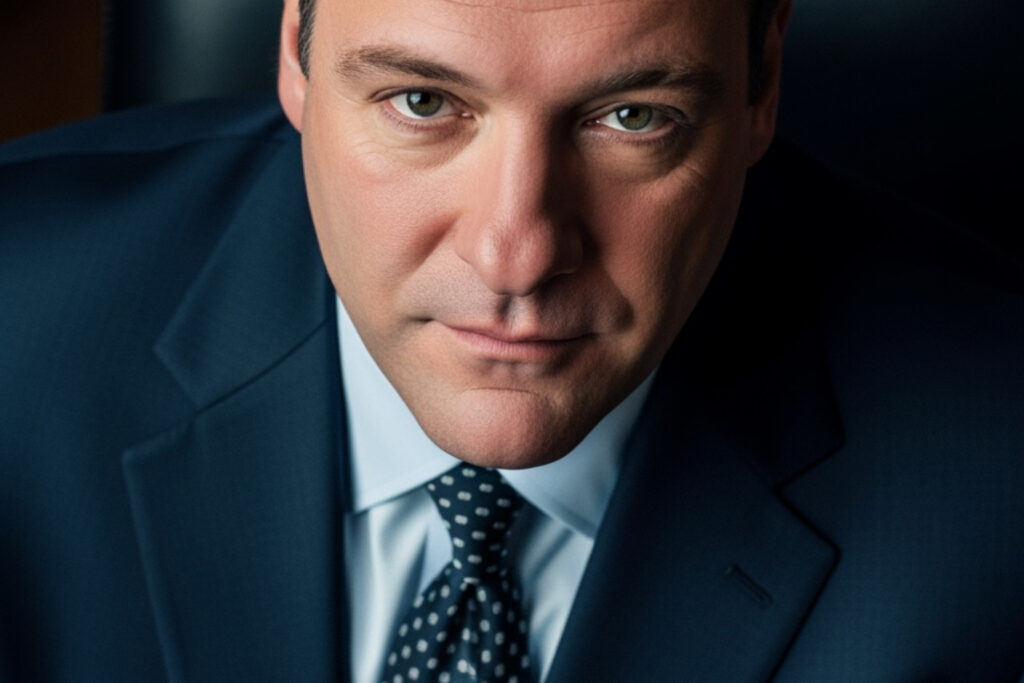More Than Just a Mob Boss
James Gandolfini was an American actor who became a cultural icon through his portrayal of Tony Soprano in HBO’s groundbreaking series The Sopranos. While most people know him as the complex mob boss who revolutionized television drama, Gandolfini’s story extends far beyond his most famous role.
Quick Facts About James Gandolfini:
- Born: September 18, 1961, in Westwood, New Jersey
- Died: June 19, 2013, in Rome, Italy (age 51)
- Most Famous Role: Tony Soprano in The Sopranos (1999-2007)
- Major Awards: 3 Emmy Awards, 1 Golden Globe, 3 Screen Actors Guild Awards
- Career Span: 50 acting credits across film, television, and Broadway
- Breakthrough Film: True Romance (1993) as Virgil the hitman
- Final Season Salary: $1 million per episode
Despite playing one of television’s most intimidating characters, those who knew Gandolfini described him as gentle, generous, and surprisingly shy. “I’m a neurotic mess. I’m really basically just like a 260-pound Woody Allen,” he once said about himself.
The New Jersey native’s Italian-American heritage deeply influenced both his personal identity and his most memorable performances. His parents, Santa and James Sr., spoke Italian at home and instilled a strong connection to their cultural roots – something that would later inform his authentic portrayal of Tony Soprano.
From his early days as a bouncer and bartender in New York City to becoming one of television’s highest-paid actors, Gandolfini’s journey reflects the classic American story of talent meeting opportunity. His unexpected death from a heart attack while vacationing in Rome shocked the entertainment world and left an enduring legacy that continues to influence actors and storytellers today.

From New Jersey Roots to the New York Stage
James Joseph Gandolfini Jr. was born on September 18, 1961, in Westwood, New Jersey, to parents who truly embodied the American dream. His father, James Joseph Gandolfini Sr., worked as a bricklayer before becoming head custodian at Paramus Catholic High School. A World War II veteran who earned a Purple Heart, he represented the hardworking immigrant spirit that would later influence his son’s most memorable performances.
His mother, Santa (Penna) Gandolfini, worked in high school food service and brought authentic Italian culture into their home. Born in the United States but raised in Naples, Italy, she ensured that Italian heritage remained central to the family’s identity. The Gandolfini household buzzed with Italian conversations, and regular trips to Italy kept young James connected to his ancestral roots.
This deep connection to Italian-American culture wasn’t just family tradition – it became the foundation for the authenticity that would make Tony Soprano so compelling. The family dinners, the passionate discussions, and the blend of Old World values with New World ambitions all found their way into Gandolfini’s later performances.
Early Life and Education
Growing up in Park Ridge, New Jersey, young James showed early hints of the charm that would later captivate millions. His Park Ridge High School classmates voted him “best-looking kid” and nicknamed him “Class Flirt” in their senior yearbook. He also played school basketball and appeared in school plays, though acting wasn’t yet on his radar as a career path.
After graduating high school, Gandolfini headed to Rutgers University, where he earned his Bachelor of Arts in Communication in 1983. During college, he worked as a bouncer at an on-campus pub – an experience that taught him how to read people and handle tense situations. These skills would prove invaluable when portraying complex, sometimes dangerous characters.
The young graduate wasn’t sure what direction his life should take. Like many recent college graduates, he moved to New York City to figure things out. He worked as a bartender and nightclub manager in Manhattan, jobs that exposed him to the city’s diverse characters and gritty atmosphere. These experiences would later inform his ability to bring authenticity to working-class roles.
Stepping onto the Stage and Screen
Gandolfini’s path to acting began almost by accident. A friend, Roger Bart, convinced him to tag along to a Meisner technique acting class. The method, which focuses on genuine listening and authentic reaction, clicked immediately with Gandolfini’s natural instincts. He found himself drawn to the craft’s emphasis on truth and emotional honesty.
While studying acting, he supported himself as a deliveryman, showing the dedication that would define his entire career. His Broadway debut came in 1992 with the revival of “A Streetcar Named Desire,” where he performed alongside Jessica Lange and Alec Baldwin. This production marked his official transition from aspiring actor to professional performer.
His stage work continued with “On the Waterfront” (1995 revival), where he played Charley Malloy. These Broadway experiences taught him the discipline and intensity needed for sustained character work – skills that would prove essential when he later took on the demanding role of Tony Soprano.
Early film roles included small parts in movies like “A Stranger Among Us” (1992), where he began building his reputation as a reliable character actor. His imposing 6’0.5″ frame and what colleagues described as a “large, chunky bear-like” presence made him perfect for tough-guy roles. However, his acting training revealed emotional depths that went far beyond his intimidating appearance.
A Film Career Defined by Intensity and Versatility
Long before James Gandolfini became a household name as Tony Soprano, he was quietly building one of Hollywood’s most impressive character actor résumés. His film career spanned over two decades, showcasing a remarkable ability to transform from menacing villain to surprisingly tender leading man.
What set Gandolfini apart wasn’t just his imposing physical presence – it was his gift for finding the humanity in every character, no matter how dark or complex. He approached each role with the same meticulous preparation that would later make Tony Soprano so unforgettable.
The Breakthrough: Virgil in ‘True Romance’

The role that changed everything came in 1993 with Tony Scott’s “True Romance.” James Gandolfini played Virgil, a brutal hitman who delivers one of the film’s most intense scenes. In a movie packed with memorable performances from Christian Slater, Patricia Arquette, and Dennis Hopper, Gandolfini somehow managed to steal the show.
What made his performance so striking was the way he balanced pure menace with unexpected vulnerability. His interrogation scene with Patricia Arquette became legendary among film fans – not just for its intensity, but for the subtle layers Gandolfini brought to what could have been a one-dimensional thug.
The role came about through a combination of talent and timing. Casting directors were looking for someone who could be genuinely terrifying yet oddly sympathetic. Gandolfini’s commitment to authenticity was already evident – he reportedly wanted Patricia Arquette to actually stab him with a corkscrew for realism (thankfully, she declined).
This breakout performance in Quentin Tarantino’s script caught the attention of Hollywood’s top casting directors. Suddenly, James Gandolfini was the go-to guy for complex villain roles that required both physical presence and emotional depth.
Notable Film Roles Beyond the Mob
After “True Romance,” Gandolfini carefully chose roles that showcased different sides of his talent. In “Get Shorty” (1995), he played Bear, a muscle-bound enforcer who brought both comedy and menace to the John Travolta vehicle. The performance was memorable enough that he reprised the role in the sequel “Be Cool” ten years later.
“Crimson Tide” (1995) put him alongside Denzel Washington and Gene Hackman in a submarine thriller where he played Lieutenant Bobby Dougherty. The role proved he could hold his own with A-list stars in high-stakes dramas.
Perhaps his most surprising pre-Sopranos performance came in “The Mexican” (2001), where he played Winston Baldry, a gay hitman who develops an unlikely friendship with Julia Roberts’ character. The role could have been a caricature in lesser hands, but Gandolfini brought genuine warmth and complexity to the character. A deep dive into his role in The Mexican reveals how he transformed what could have been a stereotype into a fully realized person.
“The Last Castle” (2001) earned him $5 million to play Colonel Winter opposite Robert Redford. As a corrupt prison warden, Gandolfini created a character who was both despicable and oddly sympathetic – a skill that would serve him well as Tony Soprano.
His later films showed an actor unafraid to experiment. “Killing Them Softly” (2012) featured him as Mickey, a hitman struggling with personal demons. “Enough Said” (2013), his final completed film, paired him with Julia Louis-Dreyfus in a romantic comedy that earned some of the best reviews of his career. The performance revealed a gentler side that audiences rarely saw.
“The Drop” (2014), released posthumously, served as a fitting farewell. Playing Cousin Marv, a bar owner caught up in money laundering, Gandolfini delivered one final performance that combined all his greatest strengths – the ability to be both threatening and vulnerable, often in the same scene.
Top James Gandolfini Film Performances:
- Virgil in “True Romance” (1993) – The breakout role
- Winston Baldry in “The Mexican” (2001) – Against-type casting
- Colonel Winter in “The Last Castle” (2001) – Authority with complexity
- Albert in “Enough Said” (2013) – Romantic leading man
- Cousin Marv in “The Drop” (2014) – Final performance
What made James Gandolfini special wasn’t just his range – it was his commitment to finding the truth in every character. Whether playing a hitman or a romantic lead, he brought the same intensity and preparation that would later make Tony Soprano one of television’s greatest characters.
The Sopranos: The Role That Defined James Gandolfini
When HBO was developing “The Sopranos,” other major networks like Fox and CBS had already passed on the project. The concept of a mob boss in therapy seemed too risky for traditional television. However, HBO’s willingness to take creative risks created the perfect home for what would become one of television’s most influential series.
Creator David Chase had a specific vision for Tony Soprano, and when James Gandolfini auditioned, something clicked immediately. Chase later said, “Without Jim Gandolfini, there is no Sopranos. There is no Tony Soprano.” The casting was so perfect that it’s difficult to imagine anyone else in the role.
The Unforgettable Performance of James Gandolfini as Tony Soprano

Gandolfini’s portrayal of Tony Soprano was for television. He created a character who was simultaneously a loving father and a cold-blooded killer, a man seeking therapy for panic attacks while running a criminal organization. This complexity had never been seen on television before.
The character was described as “by turns volcanic and brooding, honourable and devious, tender and cruel, a loving father and a husband given to serial infidelity.” Gandolfini’s performance captured all these contradictions without making Tony seem inconsistent or unbelievable.
His approach to the role was physical and psychological. To access the anger and intensity Tony required, Gandolfini used unconventional methods: he would bang his head against a wall, stay up all night, drink excessive amounts of coffee, or walk around with a rock in his shoe. These techniques helped him channel the character’s volatility and unpredictability.
The therapy sessions with Dr. Melfi, played by Lorraine Bracco, became the show’s emotional core. Gandolfini’s ability to show Tony’s vulnerability in these scenes, contrasted with his brutality in others, created a character of unprecedented depth for television.
Awards, Accolades, and On-Set Challenges
Gandolfini’s performance earned him widespread critical acclaim and numerous awards:
- 3 Primetime Emmy Awards for Outstanding Lead Actor in a Drama Series (2000, 2001, 2003)
- 1 Golden Globe Award for Best Actor in a Television Series – Drama (2000)
- 3 Screen Actors Guild Awards for Outstanding Performance by a Male Actor in a Drama Series
By the final season, Gandolfini was earning $1 million per episode, making him one of television’s highest-paid actors. However, his commitment to the role came at a personal cost. The intensity required to portray Tony Soprano was physically and emotionally draining.
Behind the scenes, Gandolfini sometimes struggled with the demands of the role. He would occasionally miss filming days, leading to HBO fining him $250,000 per day for absences. Cast and crew members later revealed that these absences were often due to the psychological burden of playing such a complex and violent character.
Despite these challenges, Gandolfini’s generosity toward his colleagues was legendary. When he renegotiated his contract for a significant raise, he shared part of his increased salary with the cast, giving checks of approximately $36,000 to his co-stars. Steven Van Zandt recalled, “He called every other cast member of ‘The Sopranos’ into his trailer and cut them checks from his own money.”
The Man Behind the Actor: Personality, Passions, and Philanthropy
The real James Gandolfini was nothing like the intimidating character that made him famous. Those who knew him personally were often struck by the gentle giant who bore little resemblance to Tony Soprano beyond his physical presence.
“He was a big, gentle, beautiful, warm, loving human,” director Jake Scott once said. Steve Schirripa, who played Bobby Baccalieri on “The Sopranos,” put it even more bluntly: “He was not Tony Soprano. You know, he was a Birkenstock-wearing, music-loving guy. He was kind of a hippie. He was not that guy at all.”
James Gandolfini had a gift for self-deprecating humor that endeared him to everyone he met. He famously described himself as “a 260-pound Woody Allen,” later updating it to “295-pound Woody Allen” as the years went by. This humility was genuine – he was genuinely uncomfortable with celebrity and preferred to deflect attention with jokes about being “just a dumb, fat guy from Jersey.”
His legendary generosity extended far beyond the famous checks he cut for his “Sopranos” co-stars. Rod Lurie, who directed him in “The Last Castle,” noted something that became a running joke among Gandolfini’s friends: “There was no such thing as bringing a wallet to any restaurant you went with James Gandolfini to.” He always picked up the check, no matter who was at the table or how expensive the meal.
Food played a central role in Gandolfini’s life, deeply connected to his Italian-American heritage. His love for authentic Italian cuisine wasn’t just about the food itself – it was about the culture of family meals and traditional cooking that his parents had instilled in him. He often spoke about the importance of gathering around the dinner table, a value that resonated with many fans who shared similar backgrounds.
This connection to food and family culture made him a natural fit for the culinary world’s appreciation of authentic experiences. His passion for real, traditional cooking over trendy restaurant scenes reflected a deeper understanding of how food connects us to our roots and to each other.
As a producer, Gandolfini chose projects that reflected his personal values and interests. He produced documentaries including “Alive Day Memories: Home from Iraq” and “Wartorn: 1861-2010,” which focused on injured Iraq War veterans and the effects of post-traumatic stress disorder. These weren’t commercial ventures – they were labors of love that demonstrated his commitment to using his platform for meaningful causes.
His support for the Wounded Warrior Project and other veteran-focused charities showed a man who understood the weight of real-world struggles, perhaps informed by his own father’s military service and Purple Heart. This compassion for others’ pain may have been part of what made his portrayal of Tony Soprano so authentic – he understood that even tough guys carry deep wounds.
An Unexpected Farewell and Enduring Legacy
The world lost a television legend on June 19, 2013, when James Gandolfini suffered a fatal heart attack while vacationing in Rome, Italy. He was only 51 years old, and his sudden passing sent shockwaves through Hollywood and beyond.
Gandolfini had traveled to Rome to attend the Taormina Film Festival, where he was scheduled to receive an award for his contributions to cinema. The tragedy unfolded at his hotel, where his 14-year-old son Michael finded him unconscious in the bathroom. Despite being rushed to the hospital immediately, doctors pronounced him dead just 20 minutes after his arrival.
The news hit the entertainment industry like a thunderbolt. Here was an actor at the height of his powers, with no apparent serious health issues, suddenly gone. The outpouring of grief and tributes that followed revealed just how deeply James Gandolfini had touched the lives of those who worked with him.
David Chase, the creator of “The Sopranos,” simply called Gandolfini “a genius.” Edie Falco, who played his on-screen wife Carmela, said he was “a man of tremendous depth and sensitivity.” Brad Pitt described him as “a fierce actor, sweet soul and truly funny man.” Perhaps most tellingly, Bryan Cranston, who played Walter White in “Breaking Bad,” acknowledged that his character “wouldn’t exist without Tony Soprano.”
The Lasting Legacy of James Gandolfini

The impact of James Gandolfini’s work extends far beyond his own performances. His portrayal of Tony Soprano fundamentally changed what television could be and do. Before Tony, TV drama was often seen as a lesser medium compared to film. Gandolfini’s nuanced, complex performance helped usher in what critics now call the “Golden Age of Television.”
His influence can be seen in every morally complex protagonist who followed. Walter White, Don Draper, Dexter Morgan – these characters all owe a debt to the template Gandolfini created with Tony Soprano. As one critic noted, “nobody could be under any illusion about what a television actor was capable of” after watching Gandolfini’s performance.
The entertainment world honored him in ways both grand and intimate. Broadway theaters dimmed their marquee lights – a tribute typically reserved for stage legends. The New Jersey Hall of Fame inducted him posthumously in 2014, recognizing his contributions to both entertainment and his home state’s cultural identity.
His hometown of Park Ridge, New Jersey, renamed a section of Park Avenue “James Gandolfini Way.” Even the Garden State Parkway’s Montvale service area bears his name now – a fitting tribute for someone who so authentically represented New Jersey culture to the world.
Gandolfini’s posthumous film releases proved he had much more to give. “Enough Said” earned a remarkable 95% rating on Rotten Tomatoes, showcasing his ability to excel in romantic comedy alongside Julia Louis-Dreyfus. “The Drop” served as a powerful final performance, reminding audiences of his gift for portraying both menace and vulnerability.
Perhaps the most touching tribute came from his own family. His son Michael Gandolfini took on the challenge of portraying a young Tony Soprano in the 2021 prequel film “The Many Saints of Newark.” Michael had to watch “The Sopranos” for the first time to prepare for the role, creating a poignant connection between father and son that brought the character full circle.
The legacy lives on in ways both expected and surprising. Television continues to push boundaries that Gandolfini helped establish. Young actors still study his performances to understand how to bring depth to complex characters. And somewhere in New Jersey, food lovers still seek out the authentic Italian-American dining experiences that James Gandolfini so passionately championed – the kind of cultural connections between food, family, and identity that made Tony Soprano feel so real to millions of viewers worldwide.
Frequently Asked Questions about James Gandolfini
How did James Gandolfini get the role of Tony Soprano?
The story of how James Gandolfini landed his career-defining role is almost as compelling as the character himself. It all started with casting director Susan Fitzgerald, who happened to see a clip of Gandolfini’s intense performance as Virgil the hitman in True Romance. Something about his raw authenticity caught her attention, and she knew he had to audition for this new HBO project.
The audition process wasn’t straightforward. During one memorable session, Gandolfini stopped midway through his reading – but instead of giving up, he asked if he could finish the audition later. That evening, he showed up at creator David Chase’s garage to complete his reading. This unconventional approach actually worked in his favor, showing the kind of dedication and unique personality that would make Tony Soprano so unforgettable.
Chase later admitted that casting Gandolfini was one of the best decisions he ever made, saying “Without Jim Gandolfini, there is no Sopranos.”
What was James Gandolfini’s net worth when he died?
When James Gandolfini passed away in 2013, his estimated net worth was around $70 million – a testament to how successful The Sopranos had become. The bulk of this wealth came from his groundbreaking television salary, which reached $1 million per episode in the final season.
To put this in perspective, Gandolfini was earning $13 million per season by the show’s end, making him one of the highest-paid actors on television at the time. His film career also contributed significantly, with movies like The Last Castle earning him $5 million paychecks.
True to his generous nature, Gandolfini’s will established trusts for his children and left substantial amounts to his sisters and widow, ensuring his family would be well cared for.
Are James Gandolfini and his son Michael Gandolfini related?
Yes, Michael Gandolfini is James Gandolfini’s son with his first wife, Marcy Wudarski. Born on May 10, 1999, Michael was just 14 years old when his father passed away – in fact, he was the one who found his father unconscious in their Rome hotel room.
Michael has chosen to follow in his father’s footsteps as an actor, and his most significant role to date has been portraying a young Tony Soprano in The Many Saints of Newark, the 2021 prequel to The Sopranos. The casting created an incredibly emotional moment for fans and provided Michael with a unique way to honor his father’s legacy.
To prepare for the role, Michael watched The Sopranos for the first time, experiencing his father’s iconic performance as both a son and a fellow actor. The connection between father and son, both on and off screen, added a deeply personal dimension to the Soprano story that continues to resonate with audiences.

Conclusion: Remembering a Titan of the Screen
James Gandolfini’s journey from a shy kid from New Jersey to one of television’s most celebrated actors represents more than just professional success – it embodies the power of authentic storytelling and genuine human connection. His change from character actor to cultural icon happened because he brought unprecedented depth and humanity to every role, most notably Tony Soprano.
What made Gandolfini special wasn’t just his ability to portray complex characters, but his commitment to truth in performance. Whether playing a brutal hitman in “True Romance” or a vulnerable mob boss seeking therapy, he found the humanity in every character. His approach to acting – intense, physical, and emotionally demanding – set a new standard for television drama that continues to influence performers today.
The impact of his work extends far beyond entertainment. The “Golden Age of Television” that began with “The Sopranos” established a template for complex, morally ambiguous protagonists that remains relevant. Characters like Walter White, Don Draper, and countless others owe a debt to Gandolfini’s groundbreaking portrayal of Tony Soprano. He proved that television could be just as powerful and artistically meaningful as any other medium.
Perhaps most importantly, James Gandolfini remained grounded despite his success. His generosity toward colleagues, his commitment to meaningful projects like his veterans’ documentaries, and his dedication to family reflected the values instilled by his Italian-American upbringing. He understood that food, family, and authentic relationships were the foundations of a meaningful life – principles that resonated deeply with audiences who shared similar cultural backgrounds.
His connection to his Italian heritage wasn’t just personal; it became part of his artistic identity. The way he portrayed family meals, the importance of tradition, and the complexity of immigrant family dynamics brought authenticity to his performances that couldn’t be taught or faked. This cultural grounding made his characters feel real and relatable, even when they were doing terrible things.
At The Dining Destination, we celebrate figures like James Gandolfini who embody the rich cultural traditions that make dining and travel experiences so rewarding. His appreciation for authentic cuisine, his understanding of how food brings people together, and his connection to his Italian roots resonate with our mission to explore the intersection of culture and culinary experiences. Explore our authentic local food guides to find the same kind of cultural connections that influenced Gandolfini’s life and work.
Though he left us too soon, James Gandolfini’s legacy lives on through his work, his son Michael’s acting career, and the countless performers he inspired. He proved that the most powerful performances come from actors who aren’t afraid to show vulnerability alongside strength, humanity alongside toughness. In a world that often values surface over substance, Gandolfini reminded us that the most compelling stories – whether on screen or around the dinner table – come from genuine human connection.
His work continues to influence actors and storytellers who understand that great art comes from truth, not pretense. James Gandolfini showed us that a gentle giant from New Jersey could become one of the most important actors of his generation simply by being authentic, generous, and committed to his craft.








1 thought on “The Ultimate Guide to James Gandolfini”
Pingback: 7 Things Mel Gibson Won’t Tell You - The Dining Destination
Comments are closed.